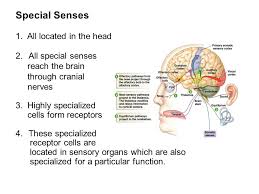
SPECIAL SENSES
Humans have five basic senses: sight, hearing, smell, taste and touch. Humans have five basic senses: touch, sight, hearing, smell and taste. The sensing organs associated with each sense send information to the brain to help us understand and perceive the world around us.
Vision is the special sense of sight that is based on the transduction of light stimuli received through the eyes. The eyes are located within either orbit in the skull. The bony orbits surround the eyeballs, protecting them and anchoring the soft tissues of the eye.
What is the Physiology of Vision? Before light can reach the rods and cones of the retina, it must pass through the cornea, aqueous humor, pupil, lens and vitreous humor. The first step in Physiology of Vision is retinal image formation and activation of Photoreceptors.Vision, humans' most important sense, involves a complicated process of converting light signals into images in the brain. Light passes through the lens, where it is focused, to the retina where photoreceptors called rods and cones convert the information to electrical impulses that can be interpreted by the brain.The inside lining of the eye is covered by special light-sensing cells that are collectively called the retina. It converts light into electrical impulses. Behind the eye, your optic nerve carries these impulses to the brain. The macula is a small extra-sensitive area in the retina that gives you central vision.Light rays enter the eye through the cornea, the clear front “window” of the eye. The cornea's refractive power bends the light rays in such a way that they pass freely through the pupil the opening in the center of the iris through which light enters the eye. The iris works like a shutter in a camera.Eye health is related to brain health. ... People with mild vascular disease that causes damage to the retina in the eye are more likely to have problems with thinking and memory skills because they may also have vascular disease in the brain, according to a new study.
The ear is a cartilaginous structure. For physiological study purposes, it subdivides into three fundamental substructures: the external ear, the middle ear, and the inner ear. The outer ear, also called auricle, is composed of cartilage and it is the part with the most contact with the external world.
The ear - a magnificent organ. The ear is an advanced and very sensitive organ of the human body. The ear's function is to transmit and transduce sound to the brain through the parts of the ear: the outer ear, the middle ear and the inner ear.
The parts of the ear include:
- External or outer ear, consisting of: Pinna or auricle. This is the outside part of the ear. ...
- Tympanic membrane (eardrum). The tympanic membrane divides the external ear from the middle ear.
- Middle ear (tympanic cavity), consisting of: Ossicles. ...
- Inner ear, consisting of: Cochlea.
- The ears are organs that provide two main functions — hearing and balance — that depend on specialized receptors called hair cells
- The function of the outer ear is to collect sound waves and guide them to the tympanic membrane. The middle ear is a narrow air-filled cavity in the temporal bone. It is spanned by a chain of three tiny bones—the malleus (hammer), incus (anvil), and stapes (stirrup), collectively called the auditory ossicles.
- The physiology of balance: vestibular function. The vestibular system is the sensory apparatus of the inner ear that helps the body maintain its postural equilibrium. The information furnished by the vestibular system is also essential for coordinating the position of the head and the movement of the eyes.
he sense of taste is mediated by taste receptor cells which are bundled in clusters called taste buds. Taste receptor cells sample oral concentrations of a large number of small molecules and report a sensation of taste to centers in the brainstem.
Taste buds are sensory organs that are found on your tongue and allow you to experience tastes that are sweet, salty, sour, and bitter.Scientists describe seven basic tastes: bitter, salty, sour, astringent, sweet, pungent (eg chili), and umami. There are however five basic tastes that the tongue is sensitive to: salt, sweet, bitter, sour, and umami, the taste of MSG.Umami translates to "pleasant savory taste" and has been described as brothy or meaty. You can taste umami in foods that contain a high level of the amino acid glutamate, like Parmesan cheese, seaweed, miso, and mushrooms. Glutamate has a complex, elemental taste.
Olfaction is a chemoreception that, through the sensory olfactory system, forms the perception of smell. Olfaction has many purposes, such as the detection of hazards, pheromones, and food. Olfaction occurs when odorants bind to specific sites on olfactory receptors located in the nasal cavity.Humans detect smells by inhaling air that contains odor molecules, which then bind to receptors inside the nose, relaying messages to the brain. Most scents are composed of many odorants; a whiff of chocolate, for example, is made up of hundreds of different odor molecules.Your sense of smell—like your sense of taste—is part of your chemosensory system, or the chemical senses. Your ability to smell comes from specialized sensory cells, called olfactory sensory neurons, which are found in a small patch of tissue high inside the nose. These cells connect directly to the brain.Anosmia is the partial or complete loss of the sense of smell. ... Common conditions that irritate the nose's lining, such as allergies or a cold, can lead to temporary anosmia. More serious conditions that affect the brain or nerves, such as brain tumors or head trauma, can cause permanent loss of smell.


